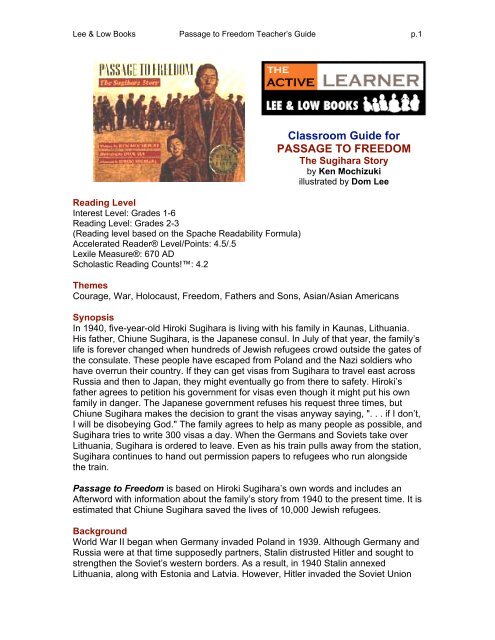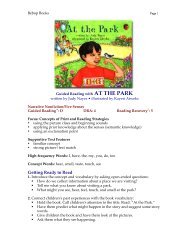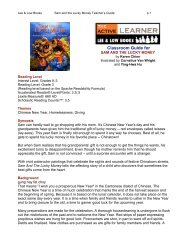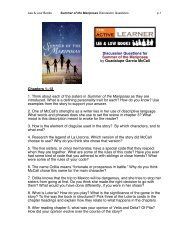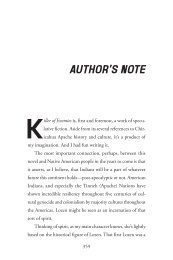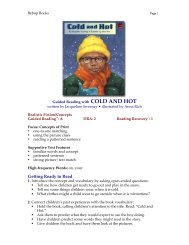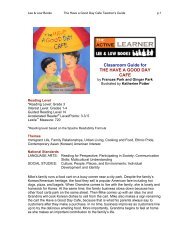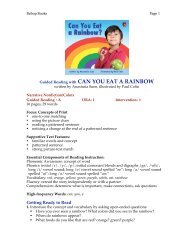Classroom Guide for PASSAGE TO FREEDOM - Lee & Low Books
Classroom Guide for PASSAGE TO FREEDOM - Lee & Low Books
Classroom Guide for PASSAGE TO FREEDOM - Lee & Low Books
Create successful ePaper yourself
Turn your PDF publications into a flip-book with our unique Google optimized e-Paper software.
<strong>Lee</strong> & <strong>Low</strong> <strong>Books</strong> Passage to Freedom Teacher’s <strong>Guide</strong> p.1Reading LevelInterest Level: Grades 1-6Reading Level: Grades 2-3(Reading level based on the Spache Readability Formula)Accelerated Reader® Level/Points: 4.5/.5Lexile Measure®: 670 ADScholastic Reading Counts!: 4.2<strong>Classroom</strong> <strong>Guide</strong> <strong>for</strong><strong>PASSAGE</strong> <strong>TO</strong> <strong>FREEDOM</strong>The Sugihara Storyby Ken Mochizukiillustrated by Dom <strong>Lee</strong>ThemesCourage, War, Holocaust, Freedom, Fathers and Sons, Asian/Asian AmericansSynopsisIn 1940, five-year-old Hiroki Sugihara is living with his family in Kaunas, Lithuania.His father, Chiune Sugihara, is the Japanese consul. In July of that year, the family’slife is <strong>for</strong>ever changed when hundreds of Jewish refugees crowd outside the gates ofthe consulate. These people have escaped from Poland and the Nazi soldiers whohave overrun their country. If they can get visas from Sugihara to travel east acrossRussia and then to Japan, they might eventually go from there to safety. Hiroki’sfather agrees to petition his government <strong>for</strong> visas even though it might put his ownfamily in danger. The Japanese government refuses his request three times, butChiune Sugihara makes the decision to grant the visas anyway saying, ". . . if I don’t,I will be disobeying God." The family agrees to help as many people as possible, andSugihara tries to write 300 visas a day. When the Germans and Soviets take overLithuania, Sugihara is ordered to leave. Even as his train pulls away from the station,Sugihara continues to hand out permission papers to refugees who run alongsidethe train.Passage to Freedom is based on Hiroki Sugihara’s own words and includes anAfterword with in<strong>for</strong>mation about the family’s story from 1940 to the present time. It isestimated that Chiune Sugihara saved the lives of 10,000 Jewish refugees.BackgroundWorld War II began when Germany invaded Poland in 1939. Although Germany andRussia were at that time supposedly partners, Stalin distrusted Hitler and sought tostrengthen the Soviet’s western borders. As a result, in 1940 Stalin annexedLithuania, along with Estonia and Latvia. However, Hitler invaded the Soviet Union
<strong>Lee</strong> & <strong>Low</strong> <strong>Books</strong> Passage to Freedom Teacher’s <strong>Guide</strong> p.2the following year, and Lithuania was occupied by the Germans until 1944. In thatyear, the Soviets–now fighting with the Allies–took over Lithuania once more.Lithuania did not gain independence again until 1990.The Holocaust was the systematic and planned extermination of Jewish people andothers by Nazi Germany during World War II. By 1945, two out of three EuropeanJews (about 6,000,000 people) had been killed.At the time this story takes place, Japan had already invaded China and had troopsin what is now Laos and Vietnam. It was the Japanese attack on Pearl Harbor in1941 that brought the United States into the war.BEFORE READINGPrereading Focus QuestionsBe<strong>for</strong>e reading the book, you may wish to have students discuss one or more of thefollowing questions as a motivation <strong>for</strong> reading.1. What is courage? What might a courageous person do that shows his or hercourage?2. What does it mean to take a risk? Can you give an example of when you orsomeone you know took a risk <strong>for</strong> something you believed was right?3. Sometimes one person does something unusual that helps many other people.How might you be able to tell that this person made a difference in the otherpeople’s lives?Setting a Purpose <strong>for</strong> ReadingInvite students to examine the front and back covers of the book. Whom might thisstory be about? What does the title suggest? Who are the people on the back cover?What do all the seals and writing represent? Ask students to write down somequestions they hope to have answered as they read the book. Suggest that studentskeep their questions in mind as they read.VocabularyThe following words have special or particular meanings in this story. Many may alsobe new to students.Hanukkah diplomat translatedrefugees visas issue/issuedexhausted cable/cabled representativepermission superiors disobeyembraced massaged reassignedabsolutely
<strong>Lee</strong> & <strong>Low</strong> <strong>Books</strong> Passage to Freedom Teacher’s <strong>Guide</strong> p.3Introduce each word and have students make three-column charts with the headingsgiven below. Each student should list the words under the heading that matches heror his knowledge of the word.I Know the Word I Have Seen or Heard the Word Be<strong>for</strong>e I Am Unfamiliar with the WordAFTER READING ACTIVITIESDiscussion QuestionsAfter reading, discuss the story with students. You may wish to use some of thefollowing questions to generate discussion.1. Why do you think people say "the eyes tell everything about a person"? What didHiroki’s father’s eyes tell the young boy at the beginning of the story?2. Where does this story take place? What was happening in Europe in 1940?3. Where were the Sugiharas from? Why were they living so far from their owncountry?4. Who were the people outside the Japanese consulate? Why do you think theythought Chiune Sugihara could help them?5. Hiroki was only five years old when the story takes place. How do you think hefelt about what was happening? How did he feel about the refugees? How did hefeel about what his family was doing?6. Why did Chiune Sugihara and his family decide to help the Jewish refugees?Was it a difficult decision? Why? What beliefs do you think the family membershad that helped them make their decision?7. Why do you think the Japanese government refused Chiune Sugihara’s repeatedrequests <strong>for</strong> visas?8. What does it mean to obey your conscience? How is this story a good exampleof obeying your conscience?9. Read aloud the two proverbs facing the title page of the book. Ask students totalk about what the proverbs mean and how they relate to the story.10. Have students reread the Afterword, or read it aloud to the class. Explain thatHiroki Sugihara wrote the Afterword as an adult to explain what happened to hisfamily after they left Lithuania. Why do you think the Soviets and Japanesegovernment treated Chiune Sugihara and his family badly after they leftLithuania? How was Sugihara finally honored <strong>for</strong> helping the refugees?11. Hiroki Sugihara now travels all over the world telling his family’s story. Why is itimportant <strong>for</strong> people to learn about the Sugiharas? What can people learn fromthem?
<strong>Lee</strong> & <strong>Low</strong> <strong>Books</strong> Passage to Freedom Teacher’s <strong>Guide</strong> p.4VocabularyHave students refer back to the word charts they made be<strong>for</strong>e reading the book. Askstudents to discuss the meaning of each word and how the word is used in the story.Have volunteers check their meanings against the dictionary meanings. Othermeanings of the words may also be discussed.Reader's Response JournalTo promote active reading, you may wish to have students keep a reader’s responsejournal. This journal will help students personalize what they are reading. Alsoencourage students to use as many of the vocabulary words as possible in theirjournal entries.1. Hiroki’s parents told him to think as if he were in someone else’s place. Thinkabout a situation where someone you know or a group of people are in need ofhelp. What would you want someone to do <strong>for</strong> you if you were in that situation?2. In recalling this story, Hiroki Sugihara shows great pride in his father’s actions.What things make you feel proud? Why?3. The Sugihara story shows that one person can make a difference in the lives ofothers. What are some ways you feel you can make a difference?4. Chiune Sugihara took an enormous risk in disobeying his government to help theJewish refugees, but he felt it was important. What are some risks you think areworthwhile? How do these differ from foolish risks?Other Writing ActivitiesAsk students to respond to one or more of the following writing activities.1. The author wrote this story from the point of view of Hiroki Sugihara. Supposeyou were one of the refugees outside the consulate. Try writing about whathappened from the point of view of a Jewish refugee from Poland.2. Work with a partner or a few classmates to think of an award you might give tohonor the Chiune Sugihara and his family. Create a name <strong>for</strong> the award and writean explanation of why the family deserves it.3. Write a poem or short paragraph that expresses your ideas about courage.ESLTeaching StrategiesThe following activities may be used with students who speak English as a secondlanguage.1. After discussing what the story is about, have students "picture read" the book.Help them identify the characters, setting, and events.
<strong>Lee</strong> & <strong>Low</strong> <strong>Books</strong> Passage to Freedom Teacher’s <strong>Guide</strong> p.52. Have two or three students work with a strong English speaker to read the book.Every few pages, have students take turns retelling what they read in their ownwords.3. Encourage ESL students who are reading the book independently to write ordictate questions about the story as they read. Set aside time to help studentsanswer their questions.INTERDISCIPLINARY ACTIVITIESTo integrate students’ reading experiences with other subject areas, you may wish tohave students complete some of the following activities.Social Studies1. Have students use a globe or world map to locate places mentioned in the story:Germany, Poland, Lithuania, Russia (the <strong>for</strong>mer Soviet Union), and Japan. Havestudents trace a path the Jewish refugees might have taken from Poland toLithuania, and across Russia to Japan. Students may also research in<strong>for</strong>mationabout which countries were receptive to refugees during World War II and wherethe people Chiune Sugihara helped might have immigrated to once they were inJapan.2. Have students do research to learn about Holocaust memorials such as YadVashem in Israel, which honored Chiune Sugihara with the "Righteous AmongNations" Award in 1985, and the U. S. Holocaust Memorial Museum inWashington, DC. As students learn about the memorials, also have them look <strong>for</strong>in<strong>for</strong>mation about other people, such as Oscar Schindler, who were active insaving Jews from the Nazis during World War II. Students should be able to findin<strong>for</strong>mation about these subjects on the Internet. Discuss why memorials existand what people can learn from them.3. Students may also search the Internet to learn more about the Sugihara familyand Chiune Sugihara’s role in helping Polish refugees escape the Nazis.In<strong>for</strong>mation about "Sugihara survivors," as mentioned in the Afterword, could beparticularly interesting.Art1. Suggest that students study the illustrations in the book. Why did the artist usebrown (sepia) tones instead of bright colors? What mood(s) do the illustrationscreate? What do the characters’ faces show about how they feel? How dopeople’s hands help explain the story? How do students think the artist felt aboutthe story?2. Have students choose a scene from the book that is not illustrated and createtheir own pictures using a variety of art materials. Encourage them to considerbe<strong>for</strong>ehand the mood and feelings they wish to convey and to choose theirillustration materials accordingly.
<strong>Lee</strong> & <strong>Low</strong> <strong>Books</strong> Passage to Freedom Teacher’s <strong>Guide</strong> p.6MathematicsRemind students that Chiune Sugihara wrote about 300 visas a day. Have studentsestimate how many days he did this if he saved about 10,000 people.ABOUT THE AUTHOR AND ILLUSTRA<strong>TO</strong>RKen Mochizuki brings his background as a newspaper journalist with an interest inAsian American issues to the children’s books he writes. In addition to Passage toFreedom, Mochizuki is the author of Baseball Saved Us, a Parents’ Choice Awardwinner, and Heroes, a Smithsonian Notable Book <strong>for</strong> Children.All three of Mochizuki’s books are linked by the theme of heroism. Says Mochizuki,"The basic theme of my first book, Basebal Saved Us, is the power of positivethinking and believing in oneself. One of the themes implicit in my second book,Heroes, is the definition of a hero as one who knows that actions speak louder thanwords. Passage to Freedom is about a moral choice: Does one do what isconsidered ‘correct’ at the time? Or does one do what is ‘right’ <strong>for</strong> all time?"Mochizuki, a native of Seattle, Washington, received his bachelor’s degree incommunication from the University of Washington. He continues to live in Seattle,but travels around the country giving presentations to schools, educational groups,and booksellers.Dom <strong>Lee</strong> has illustrated all three of Ken Mochizuki’s children’s books and hascollaborated with his wife, Keunhee <strong>Lee</strong>, to illustrate Journey Home by LawrenceMcKay, Jr. To familiarize himself with the era of each story and to ensure accuracyin his illustrations, <strong>Lee</strong> carefully researched photos and books of the period. He thenused a unique illustration process to create pictures that resonated with the moodand period of each story. After applying handmade encaustic beeswax to paper, <strong>Lee</strong>scratched out the images and then used oil paint and color pencil to add color.<strong>Lee</strong> is a native of Korea. He earned his bachelor’s degree in fine arts from theCollege of Fine Arts at Seoul National University and received his masters degree inillustration from the School of Visual Arts in New York City. He presently lives in NewJersey with his wife and children.Awards, Reviews & Comments• ALA Notable Children's Book, American Library Association• Teachers' Choices, International Reading Association (IRA)"This testament to one man's courage should be read in homes and classroomsacross the nation and the world."–SmithsonianResources on the WebLearn more about Passage to Freedomhttp://www.leeandlow.com/books/89/pb/passage_to_freedom_the_sugihara_storyPassage to Freedom in Spanish:http://www.leeandlow.com/books/154/hc/pasaje_a_la_libertad_la_historia_de_chiune_sugihara
<strong>Lee</strong> & <strong>Low</strong> <strong>Books</strong> Passage to Freedom Teacher’s <strong>Guide</strong> p.7Also by Ken Mochizuki, illustrated by Dom <strong>Lee</strong>Heroes:http://www.leeandlow.com/books/61/hc/heroesBaseball Saved Ushttp://www.leeandlow.com/books/17/hc/baseball_saved_usBaseball Saved Us in Spanish:http://www.leeandlow.com/books/141/hc/el_beisbol_nos_salvoBe Water, My Friendhttp://www.leeandlow.com/books/18/hc/be_water_my_friend_the_early_years_of_bruce_leeAlso illustrated by Dom <strong>Lee</strong>Sixteen Years in Sixteen Secondshttp://www.leeandlow.com/books/109/hc/sixteen_years_in_sixteen_seconds_the_sammy_lee_storyJourney Home:http://www.leeandlow.com/books/74/hc/journey_homeBooktalk with Ken Mochizuki on Passage to Freedomhttp://www.leeandlow.com/p/mochizuk.mhtmlBooktalk with Ken Mochizuki on Be Water, My Friendhttp://www.leeandlow.com/p/brucelee.mhtmlView other Active Reader <strong>Classroom</strong> <strong>Guide</strong>s at:http://www.leeandlow.com/p/teachers-asian_american.mhtmlBook In<strong>for</strong>mation$8.95, PAPERBACKISBN 978-1-58430-157-8$17.95, HARDCOVERISBN 978-1-880000-49-6ALSO AVAILABLE IN SPANISH:$8.95, PAPERBACKISBN 978-1-880000-82-3$16.95, HARDCOVERISBN 978-1-880000-81-632 pages, 10” x 9”Interest Level: Grades 1-6Reading Level: Grades 2-3(Reading level based on the Spache Readability Formula)Accelerated Reader® Level/Points: 4.5/.5Lexile Measure®: 670 ADScholastic Reading Counts!: 4.2Themes: Courage, War, Holocaust, Freedom, Fathers and Sons
<strong>Lee</strong> & <strong>Low</strong> <strong>Books</strong> Passage to Freedom Teacher’s <strong>Guide</strong> p.8Order In<strong>for</strong>mationOn the Web:http://www.leeandlow.com/books/154/pb/pasaje_a_la_libertad_la_historia_de_chiune_sugihara (secure on-line ordering)http://www.leeandlow.com/p/ordering.mhtml (general order in<strong>for</strong>mation)By Phone:212-779-4400 ext. 25212-683-3591 faxBy Mail:<strong>Lee</strong> & <strong>Low</strong> <strong>Books</strong>, 95 Madison Avenue, NY NY 10016Copyright © 1997-2003 The Active Learner<strong>Lee</strong> & <strong>Low</strong> <strong>Books</strong>, all rights reserved.For questions, comments and/or more in<strong>for</strong>mationplease contact us at info@leeandlow.com


